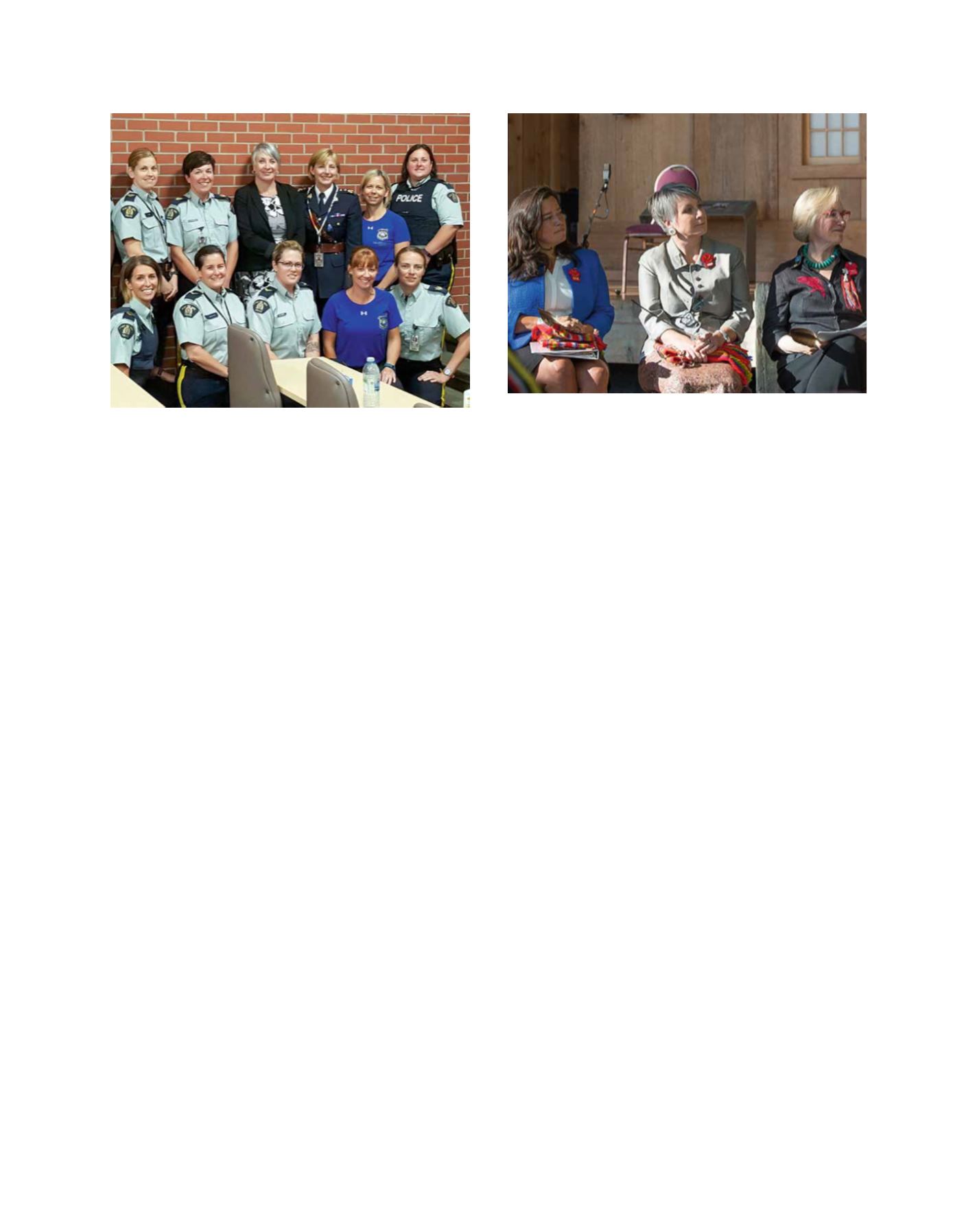

Minister Patty Hajdu with members from the Royal Canadian Mounted Police
Image: SWCCFC
[
] 44
A B
etter
W
orld
to report any kind of sexual harassment than men – 43 per cent
for women versus 12 per cent for men. Women were also more
than twice as likely to report unwanted touching than men.
Overall police-reported crime, including violent crime, is
decreasing. But rates of certain types of violence that dispro-
portionately affect women and girls have increased, including
sexual assault, online child exploitation, luring and online
harassment. From 2013 to 2014, police-reported sexual assault
among female victims increased 19 per cent. There were also
83 intimate partner homicides in 2014, up from 72 in 2013.
The rates of violent crime against women in our three
northern territories are up to eight times higher than the rates
of these crimes in our provinces. Equally disturbing is the fact
that Indigenous women and girls in all parts of Canada face
violent crime rates up to three times greater than those for
non-Indigenous women and girls.
The issue of missing and murdered Indigenous women in
Canada has received national and international attention.
Rights organizations, Indigenous groups, academics and many
others have long argued that this was an issue that urgently
needed to be addressed. Amnesty International raised the
issue in 2004, and it was also flagged by The United Nations
and Inter-American Commissions on Human Rights in 2015.
Here in Canada, a 2014 report by the Royal Canadian
Mounted Police (RCMP), examined all police jurisdictions
across the country. The review accounted for the murder of
1,017 Indigenous women and girls and the disappearance of
164 Indigenous females. A 2015 update to the RCMP report
added 32 Indigenous female homicide cases and 11 additional
missing Indigenous women and girls.
The RCMP also confirmed that Indigenous women are
‘over-represented’ among Canada’s missing and murdered
women, something affected families and advocates had been
highlighting for many years. Indigenous women made up 16
per cent of all women murdered in Canada between 1980 and
2012, but comprised only 4 per cent of Canada’s female popu-
lation. Meanwhile, the homicide rate for Indigenous women
has remained unchanged over the past three decades while
it has been declining for non-Indigenous women in Canada.
Clearly, this tragic situation needs to be addressed.
The Government of Canada recognizes the severity of this
tragedy and is committed to reducing the levels of violence
that disproportionately affect Indigenous women and girls.
Among other initiatives, we have launched a national inquiry
to help us better understand the systemic nature of the
violence and what actions must be taken to end it.
As Minister of the Status of Women, I joined with the
Ministers of Justice and Indigenous and Northern Affairs to
design this inquiry.
Our challenge was to ensure that the mandate and composi-
tion of the commission reflected the needs and expectations
of those most directly affected. We knew that meeting directly
with families and survivors was the collaborative and inclusive
approach needed to ensure its success.
In winter 2016, my colleagues and other senior departmen-
tal officials met with survivors, families and representatives of
support organizations who work with women at risk. In total,
we met more than 2,000 people affected by the tragedies.
We took special steps to ensure that all the participants
were safe, supported and respected. A wide range of cultural,
spiritual and religious ceremonies were included at each
meeting. Elders were on hand to provide ceremony and
counsel and Health Canada workers were available at all
times to provide additional cultural and emotional support
and to ensure the well-being of participants. We also gave
survivors, families and loved ones as much advance notice
as possible to enable their participation in meetings in their
regions. The Government covered the costs of travel and
accommodation for family members and individuals from
support groups.
In addition to meeting with survivors and their families, we
met with Indigenous leaders, provincial and territorial leaders,
local front-line support organizations, community representa-
tives, scholars and legal experts.
It is clear that Indigenous and non-Indigenous people
want to see justice for victims and their families. They also
want to see systemic change that will address the underlying
causes of violence.
Government of Canada Ministers: Jody Wilson-Raybould, Patty Hajdu and
Carolyn Bennett
Image: SWCCFC
















